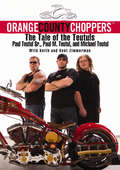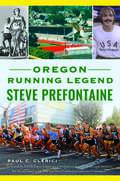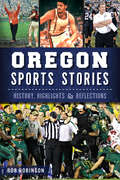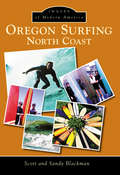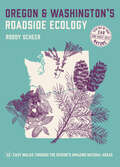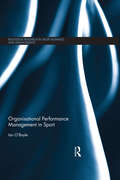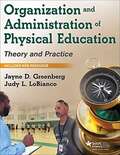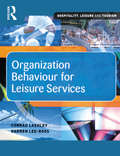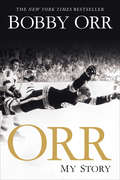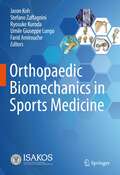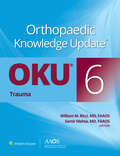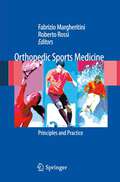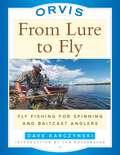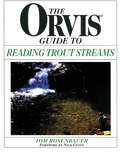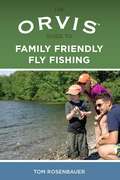- Table View
- List View
Orange County ChoppersTM: The Tale of the Teutuls
by Paul M. Teutul Michael Teutul Paul Teutul Sr.Each week, millions of viewers tune into The Discovery Channel to watch their favorite dysfunctional American family, the Teutuls. The hit TV show American Chopper features Paul Teutul, Sr., and his sons Paul, Jr. and Mikey, along with a supporting cast of mechanics and friends. Together, they create some of the most incredible and outrageous motorcycles in the world. Now, in Orange County Choppers, the Teutuls combine family history with a behind-the-scenes tour of their renowned motorcycle shop-and their new lives as household names. Hilarious and heartwarming, fans of the show and newcomers alike will delight in this truly authentic America success story.
Ordinary Joe
by Joe Schmidt'He's a great coach. He lives and breathes the game. There's nothing he doesn't know' Brian O'Driscoll'The best coach Irish rugby - arguably Irish sport - has ever had' Malachy Clerkin, Irish TimesIn the autumn of 2010, a little-known New Zealander called Joe Schmidt took over as head coach at Leinster. He had never been in charge of a professional team. After Leinster lost three of their first four games, a prominent Irish rugby pundit speculated that Schmidt had 'lost the dressing room'.Nine years on, Joe Schmidt has stepped down as Ireland coach having achieved success on a scale never before seen in Irish rugby. Two Heineken Cups in three seasons with Leinster. Three Six Nations championships in six seasons with Ireland, including the Grand Slam in 2018. And a host of firsts: the first Irish victory in South Africa; the first Irish defeat of the All Blacks, and then a second; and Ireland's first number 1 world ranking.Along the way, Schmidt became a byword for precision and focus in coaching, remarkable attention to detail and the highest of standards. But who is Joe Schmidt? In Ordinary Joe, Schmidt tells the story of his life and influences: the experiences and management ideas that made him the coach, and the man, that he is today. And his diaries of the 2018 Grand Slam and the 2019 Rugby World Cup provide a brilliantly intimate insight into the stresses and joys of coaching a national team in victory and defeat.From the small towns in New Zealand's North Island where he played barefoot rugby and jostled around the dinner table with seven siblings, to the training grounds and video rooms where he consistently kept his teams a step ahead of the opposition, Ordinary Joe reveals an ordinary man who has helped his teams to achieve extraordinary things.'Rugby obsessives and amateur coaches will revel in the insight that Schmidt offers into his training methods, tactics and preparation ... Full of insight, emotion and considered analysis' Irish Daily Mail'An insight into the fascinating personality of the man who has been the single most influential figure in Irish rugby over the last decade' Irish Times'He is clearly more than an ordinary coach, the winning of two Heinekens, beating New Zealand twice, the 2018 Grand Slam and reaching no.1 in the World Rankings are positive brushstrokes, marking Irish rugby for ever ... A rocky read about exceptional deeds, told in extraordinary fashion' Irish Daily Star'Undoubtedly the greatest coach in Irish rugby history' Daily Telegraph
Oregon Prizefighters: Forgotten Bare-knuckle Champions of Portland & Astoria (Sports)
by Barney BlalockIn 1884, London's prizefighting craze spread to Portland. Since the fights were illegal throughout the States, matches were fought in inconspicuous venues away from unwanted spectators. A winner could be hanged if the loser died. Champions like Dave Campbell, Jack "Nonpareil" Dempsey and "Mysterious" Billy Smith were just a few contenders for the brutal, nearly forgotten sport. Join author Barney Blalock as he reveals the remarkable stories of Oregon's bare-knuckle champions.
Oregon Running Legend Steve Prefontaine (Sports)
by Paul C. Clerici Pat TysonIn the Footsteps of Oregon's beloved U.S. Olympic Athlete, Activist, and IconBorn in the small town of Coos Bay, Oregon, Steve "Pre" Prefontaine's meteoric rise to cross-country and track superstardom included national recognition in high school followed by state, national, and world records. From the University of Oregon track to a fourth-place finish in the 1972 Munich Olympic Games, he never stopped striving to make his mark on the world. Even today, his name conjures up images of athleticism, activism, and charisma. While his life tragically ended in a car accident at the youthful age of 24 - at which time he owned every American record from 2,000 to 10,000 meters and two to six miles - his legacy lives on.Join author and runner Paul C. Clerici as he brings you this legendary Oregon athlete.
Oregon Sports Stories: History, Highlights & Reflections (Sports)
by Bob RobinsonOregon has its share of playmakers, dramatic finishes and legendary coaches. With humor and insight, Oregon native and longtime sportswriter Bob Robinson relates highlights from six decades of coverage throughout the state. Blazermania overruns the Rose City as the Trail Blazers take down the favored Philadelphia 76ers in 1977. Oregon State's Orange Express, coached by Ralph Miller, captivates the state in 1981 before a shocking stumble in the NCAA playoffs. University of Oregon's Bill Dellinger kickstarts the school's distance-running tradition with a stunning win in 1954. In the 1970s, Mouse Davis performs coaching magic at Portland State with his Run and Shoot football offense. In these twenty essays, Robinson offers a unique, behind-the-scenes account of some of Oregon's greatest sports moments and game-changing personalities.
Oregon Surfing: North Coast (Images of Modern America)
by Sandy Blackman Scott BlackmanSurfing culture began in Portland, Seaside, Cannon Beach, and Pacific City in the early 1960s. Influenced by surf music and a few California surfers, a handful of skin divers and adolescent boys yearned to engage in the sport. In the beginning, surfing was illegal along the beachfronts of Seaside and Cannon Beach. Answering the siren call, locals took to the beaches, while others from around Oregon, Washington, and California found their way to isolated spots along the Northern Oregon coast. The early surfers were not intimidated by their lack of knowledge, poor equipment, or the unpredictable waves. Instead, surfing caught on in the cold waters of Oregon. Experience the early days of Oregon surfing through the pioneer surfers' stories and vintage photographs.
Oregon and Washington's Roadside Ecology: 33 Easy Walks Through the Region's Amazing Natural Areas
by Roddy ScheerDiscover natural history secrets hiding in plain sight Have you ever seen a raging river disappear completely into a lava tube? Petrified subtropical plants in the middle of a high desert? Do you know how a 10,000-year-old argillite boulder can wind up 800 miles away from any similar rocks? In this insightful guide, environmental journalist and photographer Roddy Scheer reveals the hidden stories of the Pacific Northwest&’s unique ecosystems and teaches you how to &“read a landscape,&” as you explore 33 spectacular natural areas. All hikes are within easy walking distance of the road, less than two miles long, and include clues to deciphering the terrain—making Oregon and Washington&’s Roadside Ecology a must-have guide to some of the area&’s most spectacular and unusual natural sights.
Organisational Performance Management in Sport (Routledge Research in Sport Business and Management)
by Ian O'BoyleEffective performance management systems are essential in any successful organisation. In both commercial sport business and not-for-profit sport organisations, the pressure to follow international best practice in performance management has grown significantly in recent years. Organisational Performance Management in Sport is the first book to show how performance management concepts, tools and principles can be applied in the modern sport environment. Linking theory and practice throughout, the book defines fundamental performance parameters impacting on sport organisations, and introduces key issues such as individual performance management through to board-level governance structures, presenting extended real-world case studies and practitioner perspectives. As such, it offers the most clear and complete outline of performance management in sport organisations available. With case studies, insight boxes and industry examples integrated throughout the text, Organisational Performance Management in Sport offers accessible and vital reading for all sport management students, researchers and professionals with an interest in this important area of sport management research and practice.
Organization And Administration Of Physical Education: Theory And Practice
by Jayne D. Greenberg Judy L. LoBiancoIf you want to know how to be the best, you learn from the best. Two SHAPE America Physical Education Administrators of the Year share what it takes to be an outstanding administrator in Organization and Administration of Physical Education: Theory and Practice. Jayne Greenberg and Judy LoBianco, veteran leaders in the field with decades of successful administration experience, head a sterling list of contributors who have taught at the elementary, middle school, high school, and college levels in urban, suburban, and rural settings. Together, these contributors expound on the roles and responsibilities of physical education administrators through both theoretical and practical lenses. The result is a book that will be highly useful to undergraduate students looking to enter the field, as well as a resource for administrators in physical education leadership positions who are looking to acquire new skills and innovative ideas in each of the five areas of responsibility covered in the book. Part I covers leadership, organization, and planning. It explores leadership and management styles and presents practical theories of motivation, development, and planning. It also looks at how to plan for the essential components of an effective, quality physical education program. In part II, readers examine various curriculum and instruction models and navigate through curriculum theory and mapping. This section also offers guidance on planning events, including special programs and fundraising projects, and how to build a team and secure community connections for those special events. Part III helps administrators plan and design new school sites or renovate existing ones, and it presents contemporary concepts in universal design and sustainable environmental design. It also offers ideas on how to incorporate technology to meet the needs of 21st-century learners, including the use of social media and robotics in delivering instruction and communication. Part IV explores written, verbal, and electronic communication issues, as well as legal and human resource issues. Administrators learn how to lobby and advocate for physical education, how the legal system affects schools, and how to examine personnel issues, bullying, and harassment. Part V explains the fiscal responsibilities inherent in administrative positions, including budgeting, bidding, and purchasing. It also shows how administrators can secure funding independent of district or local funding, offering many examples of grants and fundraising opportunities with sample grant applications. Throughout the text, special features—Advice From the Field and Leadership in Action—share tips, nuggets of wisdom, and examples of administrators excelling in their various responsibilities. The book also comes with many practical examples of forms that are useful in carrying out responsibilities, and each chapter offers objectives, a list of key concepts, and review questions to facilitate the learning. In addition, the text has related online resources consisting of supportive materials and documents. Organization and Administration of Physical Education: Theory and Practice, published with SHAPE America, offers the solid foundational theory that administrators need and shows how to put that theory into daily practice. Note: A code for accessing HKPropel is included with all print books.
Organization Behaviour for Leisure Services
by Darren Lee-Ross Conrad LashleyOrganization Behaviour for Leisure Services provides the reader with the conceptual tools necessary for analysing organizational behaviour in the context of hospitality, leisure and tourism provision, and understaanding events in order to take appropriate management action.Taking the view that leisure services involve an array of industry sectors - they are related, for instance, to work-time spent eating, drinking and staying away from home, as well as the more obvious recreational pursuits - the text uses examples and case studies from a wide range of international businesses such as hotels, restaurants, museums, shopping malls and sports stadia. Specific examples used are from Marriotts, McDonald's, Trafford Centre and many more. With a user-friendly structure and style, the text is an ideal introduction to the fundamental issues involved - perfect for students and managers alike. This book discusses and questions a number of key elements, including: The individual and the organization Groups in the organization Organizational structures and behaviour Management within the organization Commercial hospitality, leisure and tourism in a service context There is a Tutor Resource pack available to lecturers who adopt this text. Accredited lecturers can request access to download this material by going to http://books.elsevier.com/academic/defaultmanuals.asp? to request access.
Organizational Behaviour in Sport (Foundations of Sport Management)
by Bob Stewart James SkinnerWhat makes a sport enterprise successful? How can managers working in sport improve organizational effectiveness through strategic behaviour management? This comprehensive and accessible textbook addresses these important questions and examines the theories that underpin organizational analysis in sport. Helping both students and practitioners to understand the different types of behaviour that occur within a sports enterprise, it also demonstrates how to develop ways of managing behaviour more effectively for the benefit of all stakeholders. The book explores behaviour on individual, interpersonal, group and whole-organization levels, and presents an evidence-based framework for analysis built around key concepts such as: Change and culture Leadership Motivation, rewards and incentives Power and influence Conflict, disputes and grievances Equity, diversity and inclusion. With international case studies, learning objectives, review questions and guides to further reading included in every chapter, no other textbook develops critical skills or an awareness of ethical issues in such detail and depth. Organizational Behaviour in Sport is essential reading for all students and practitioners working in sport, leisure or recreation management.
Orienteering
by Steven BogaMap and compass reading, programs and courses, skills quizzes and exercises, conditioning and nutrition advice, and rules for competitors.
Orp Goes to the Hoop
by Suzy KlineAll-star baseball pitcher Orp goes out for basketball in the seventh grade, and finds that the skills he has developed in his old sport can be effectively transferred to his new one.
Orr: My Story
by Bobby OrrThe NHL legend tells his story from his Ontario childhood to his years with the Bruins and Blackhawks, to today. New York Times Bestseller! Bobby Orr is often referred to as the greatest defenseman ever to play the game of hockey. <P><P>But all the brilliant achievements leave unsaid as much as they reveal. They don't tell what inspired Orr, what drove him, what it was like for a shy small-town kid to suddenly land in the full glare of the media. They don't tell what it was like when the agent he regarded as a brother betrayed him and left him in financial ruin. They don't tell what he thinks of the game of hockey today.Now he breaks his silence in a memoir as unique as the man himself...Includes photographsand I believe that I have lessons worth passing on." Orr: My Story is more than a book about hockey--it is about the making of a man.
Orthobiologics: Injectable Therapies for the Musculoskeletal System
by Norimasa Nakamura Bert R. Mandelbaum Giuseppe Filardo George F. Muschler Scott A. RodeoThis book presents the evidence related to the use of injectable biologics to provide faster and better healing for musculoskeletal lesions and conditions. The authors discuss approaches, such as blood derivatives and cell concentrates, applied to lesions of muscles, ligaments, tendons, bones, meniscus and cartilage, as well as osteoarthritis. Chapters are written by some of the most influential opinion leaders in the field, with up-to-date review of the current literature, where the authors explore both the potential and the limitations of these minimally invasive and promising treatments.The first section is devoted to the formulations and rationale for the use of injectable orthobiologics, while the second section reviews current treatment methods applied to specific joints and pathologies – ranging from tendinopathies through non-unions to articular degenerative processes – as well as the results of these treatment approaches. The third section explores future perspectives, such as pluripotent stem cells, gene therapy, and the stimulation of intrinsic stromal cell niches. Appealing to a broad readership, this book will be of interest to both laboratory research scientists and clinicians, including orthopedists, sports physicians, physiatrists, and regenerative medicine experts.
Orthopaedic Biomechanics in Sports Medicine
by Stefano Zaffagnini Ryosuke Kuroda Umile Giuseppe Longo Farid Amirouche Jason KohThis book presents a fundamental basic overview of orthopedic biomechanics in sports medicine, with a special focus on the current methodologies used in modeling human joints, ligaments, and muscle forces. The first part discusses the principles and materials, including the use of finite element analysis (FEA) to analyze the stress-strain response in the implant-bone interface and design. The second part focuses on joint-specific biomechanics, highlighting the biomechanics of the knee and shoulder joints, their modeling, surgical techniques, and the clinical assessment of joint performance under various kinematic conditions resulting from different repair techniques. Written by international experts working at the cutting edge of their fields, this book is an easy-to-read guide to the fundamentals of biomechanics. It also offers a source of reference for readers wanting to explore new research topics, and is a valuable tool for orthopedic surgeons, residents, and medical students with an interest in orthopedic biomechanics.
Orthopaedic Knowledge Update: 14 (Orthopaedic Knowledge Update)
by Frederick M Azar Leesa M GalatzOrthopaedic Knowledge Update® 14, edited by Leesa M. Galatz, MD, MBA, FAAOS, and Frederick M. Azar, MD, FAAOS, brings you a comprehensive synthesis of the latest clinical thinking and best practices across all orthopaedic specialty areas. OKU® 14 covers developments of the last three years with revisions and updates based on new evidence, outcomes, and innovations in the recent literature, including annotated references. Keep pace with the rapidly evolving body of orthopaedic knowledge and clinical practice with OKU’s objective, balanced coverage. Backed by clinical research, informed by practical experience, and rigorously edited by thought leaders across the orthopaedic specialties, OKU®14 is your most up-to-date resource to guide your delivery of high-quality orthopaedic patient care today.
Orthopaedic Knowledge Update®: Trauma (AAOS - American Academy of Orthopaedic Surgeons)
by Samir Mehta William M. RicciDeveloped in partnership with the American Academy of Orthopaedic Surgeons (AAOS) and edited by William M. Ricci, MD, FAAOS and Samir Mehta, MD, FAAOS, Orthopaedic Knowledge Update®: Trauma 6 brings together relevant knowledge and new breakthroughs in orthopaedic trauma treatment and management from the most recent 5 years of orthopaedic and subspecialty literature, as well as core knowledge from previous years.
Orthopedic Rehabilitation: Principles and Practice
by Alfred J. Tria S. Ali Mostoufi Tony K. GeorgeThis pocket-sized guide provides a practical and comprehensive resource for orthopedic, PM&R, and musculoskeletal specialists, as well as primary care physicians who work in the community outpatient clinic setting. Its consistent chapter format covers each area with anatomy, physical examination, preoperative management, and postoperative rehabilitation sections for the spine and extremities. The book presents treatment protocols for various injuries, including physical therapy measures such as weight bearing status, PRE, closed or open chain exercises, and timing for returning to routine or sport activities. Its concise presentation of rehabilitation for the upper and lower extremities, the hip and pelvis, and the spine enables quick reference and clinical decision-making. Furthermore, the book includes a chapter on rehabilitation following the use of orthobiologics, making it a valuable resource for healthcare professionals involved in orthopedic rehabilitation after regenerative interventions.
Orthopedic Sports Medicine
by Roberto Rossi Fabrizio MargheritiniAim of this book is to give an update on the main issues in sports traumatology and orthopedics, involving different body sections. Exploring the most important aspects of sports medicine - from anatomy to normal movements description, from diagnosis to sports injuries treatment, from conservative to surgical treatments - it gives a global overview of the field, describing also diagnostic tools recently introduced in this field, such as hip arthroscopy, and taking into consideration related areas like nutrition, prevention, training and rehabilitation. The single chapters deal with relevant problems such as emergencies on the field, pathologies of the upper and lower extremity, spine problems in athletes. Each injury is approached on the basis of both the specific body area and of the different sports/activities. Written by a multidisciplinary team of experts, this volume will be a fundamental book for orthopedic surgeons, physiotherapists, general practitioners, personal and athletic trainers, offering them a useful tool for the management of most frequent injuries in sports medicine.
Orthopedics for Physician Assistant and Nurse Practitioner Students: An Introductory Guide
by John A. GracyThis practical introductory guide provides PA/NP students with the tools to recognize and begin treatment of the most common orthopedic problems, to avoid missing critical diagnoses, and to serve as a base of knowledge to which they can add depending on their chosen career path. Utilizing this concise text, PA/NP students will gain a basic familiarity with how to describe a problem (including imaging) to an orthopedic surgeon as well as how to begin treatment. In addition, the student should have no difficulty passing the orthopedic portion of the PA/NP credentialing exams. The essentials of imaging, fracture description and operating room procedures are presented first. Then, proceeding anatomically from upper to lower extremity and the spine, chapters utilize a user-friendly chapter format covering fractures, dislocations and trauma as well as non-traumatic injury, focusing on pathophysiology, diagnosis and differential diagnosis, and brief treatment protocols. Since many PAs are office-based, only the highlights of surgery are presented, with an emphasis on what to look for regarding post-operative complications as well as the goals of the rehabilitation process (both non-operative and post-operative).Many books intended for orthopedic PA/NP students are written for those already in practice, usually providing far more information than the student can absorb in the usual 4-week orthopedic rotation, while others tend to skip important areas. This guide provides concise yet comprehensive coverage for a well-rounded presentation of everything orthopedic PA/NP students need to know to succeed.
Orvis From Lure to Fly: Fly Fishing for Spinning and Baitcast Anglers
by Dave KarczynskiFor any angler who wonders: "What's this fly fishing thing all about?"What makes this ground-breaking book different from other entry-level fly fishing texts is that it speaks directly to anglers who are already proficient with conventional fishing tackle--spinning and baitcasting gear. Rather than take a start-from-scratch approach to fly fishing, this book helps anglers translate and transfer their existing knowledge base and skill set as it introduces and reinforces core fly fishing concepts. Covering bluegill, bass, trout, steelhead, salmon, pike, muskie and even carp, each chapter gives the new fly angler all the tools they need for chasing their favorite species with a fly rod. Whether you prefer wading small rivers or fishing big water from a boat, this book is your best gateway to the fascinating world of fly fishing.
Orvis Guide To Reading Trout Streams (Orvis)
by Tom RosenbauerA complete guide to where trout live and feed in a stream, graced with dozens of helpful schematic drawings and more than seventy-five revealing photographs.
Orvis Guide to Better Fly Casting: A Problem-Solving Approach (Orvis)
by Al KyteFly casting might look easy—you just move the rod back and forth, right? Yes, that&’s true, but between &“back&” and &“forth,&” a lot can go wrong. The perfect marriage of human skill and dexterity to the cork and graphite of today&’s fly rods takes a good bit of work, and this is the how-to book that gets you around common mistakes and bad moves so that you can develop the muscle memory that makes for easy, accurate, and highly successful fly casting. Author Al Kyte&’s instruction, with numerous full-color photographs, breaks down the parts of the cast to get you to better understand what is happening and how to put all of the parts of your cast together to make noticeable improvements.
Orvis Guide to Family Friendly Fly Fishing (Orvis)
by Tom RosenbauerThe Orvis Book of Family Friendly Fly FishingLike all sports, the fun of fly-fishing lies in sharing the experience and in spending time with those closest to you. And yet for a father unsure how to connect with his bored, PlayStation-dazed kids, for a beginning fisherman who doesn’t want to learn casting techniques by himself, for a mother who would love to show her children the outdoors but isn’t quite sure how to begin, it can be a frustrating and intimidating business.From one of the most trusted brands in the industry, and from one of the sport’s most esteemed authors, The Orvis Guide to Family-Friendly Fly-Fishing by Tom Rosenbauer will take the mystery out of sharing the experience.Rosenbauerprovides instructional guidance, discusses the nuts and bolts of casting, fly choice, and technique, and opens the lens to discuss family-friendly destinations, gear, schools, safety, and more.Rosenbauer brings his expertise to bear on perhaps the most essential skill set of all—introducing the people closest to you to your beloved sport.Tom Rosenbauer, host of the Orvis Fly Fishing Podcasts, has been with the Orvis Company over 30 years. Rosenbauer is Fly Rod & Reel magazine's 2011 Angler of the Year and author of The Orvis Fly-Fishing Guide, one of the best-selling fly-fishing books ever.
